Did you know that a common plant growing right in your backyard could hold the key to better health? Stinging nettle, a medicinal powerhouse found almost everywhere and free for the taking, has been celebrated for centuries for its incredible health benefits and versatility. Personally, it’s become a staple in my life, especially for its amazing benefits for women’s health. In this article, I’ll explore the fascinating history of stinging nettle, dive into why it’s so beneficial, and guide you through making a simple yet powerful infusion—one you’ll never want to miss, because it’s just that good.
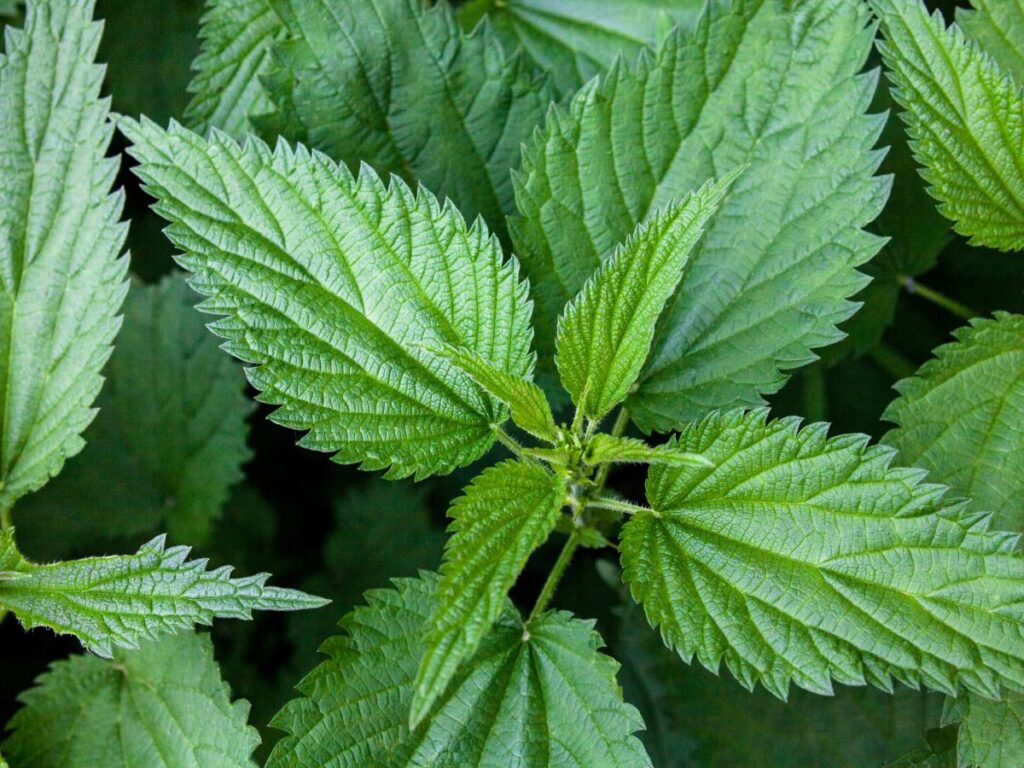
The Power of Stinging Nettle
What is Stinging Nettle?
Stinging nettle, scientifically known as Urtica dioica, is a perennial plant easily recognized by its serrated leaves and tiny, stinging hairs. Trust me, you can’t mistake it for anything else! I bet everyone has had their own, slightly uncomfortable encounter with this plant. Remember that sharp sting when you accidentally brushed against it? Ouch! It’s because those little hairs contain chemicals that irritate the skin. But don’t let that scare you off—this plant is an absolute treasure trove of health benefits. In fact, nettle is even said to help with conditions like arthritis.
Stinging nettle typically grows in nutrient-rich soil, and you’ll often find it in woodlands, meadows, and along riverbanks across Europe, Asia, and North America. It’s so abundant, spreading like wildfire, which to me shows the plant’s resilience and the spiritual abundance it offers us.
And I have to say—I love, love, love stinging nettle.
Historical Use in Medicine
Let’s dive into the fascinating history of stinging nettle, shall we?! I get so excited thinking about how our ancestors turned to nature for healing, using herbs in everything from tinctures and teas to infusions and potions. And stinging nettle? Well, it’s been a star of the herbal world for centuries!
The ancient Greeks and Romans were onto something when they used nettle to ease pain and inflammation, and medieval herbalists also held this plant in high regard. Nettle was their go-to remedy for a variety of ailments, from soothing arthritis to helping with respiratory issues. Can you imagine how comforting it must have been to turn to such a readily available plant for healing?
What I love most is that despite all the modern advances in medicine, nettle still stands the test of time as a potent, natural healer. It’s like a living testament to how powerful nature can be. Isn’t it incredible to think that something so simple and abundant has played such a huge role in the health practices of our ancestors?
Going Back to Nature
It’s my deepest hope that more women rediscover the medicine woman archetype within themselves and reconnect with nature, tapping into the wisdom passed down through generations of women before us. We all have that ancient knowledge stored within us, waiting to be awakened.
I truly believe that when we begin to connect with the natural world and embrace its medicinal treasures, we activate the medicine woman within. This connection opens us up to a deeper sense of healing and awareness, both physically and spiritually. There’s something so powerful about stepping into the wild, gathering herbs with our own hands, and feeling that direct connection to nature’s cycles.
My wish is for women to get out into the woods, collect wild herbs, and rediscover the healing potential that exists in the world around—and within—us. By doing so, we not only heal our bodies, but also reconnect with our inner selves and the natural rhythms of life.
Why Stinging Nettle is So Healthy
Nutritional Benefits
Okay, now let’s get into the deeper nutritional benefits of this powerhouse of a plant! Are you as excited as me?! 😉
One of the reasons stinging nettle is so highly regarded is its impressive nutritional profile. The plant is packed with essential vitamins and minerals, including vitamins A, C, and K, as well as iron, calcium, and magnesium. So important when we are menstruating! But these nutrients contribute to our overall health not only during our cycle, and support everything from immune function to bone strength. I mean! And did I tell you, it’s absolutely for free?! 😉
Health Benefits for Women
Ladies, if you’re still menstruating, then stinging nettle needs to be part of your supplement regimen—period! This amazing herb offers a wealth of health benefits, especially for us women. It’s been praised for its ability to support urinary health, reduce inflammation, and most importantly, balance our hormones. Nettle can be incredibly helpful in managing symptoms related to both the menstrual cycle and menopause.
Personally, I drink plenty of nettle infusion or nettle tea during my moon (menstruation) to nourish my body with the nutrients it craves during this powerful, yet often challenging, phase of our cycle. I mean, think about it—each cycle, a woman’s body essentially loses a chunk of its immune system during the bleed. So, we need all the extra support we can get! For me, stinging nettle is the perfect remedy to help replenish and restore what’s lost, making it a true lifesaver during that time. My body literally absorbs it!
Plus, Medical Medium hypes stinging nettle’s health benefits in his amazing book Life- Changing Foods: “Nettle leaf is a wonderful centering herb for anyone who is highly distractible and scattered.” I couldn’t agree more! It’s not just about the physical benefits—nettles have a grounding effect on the mind and spirit, too.
If you’re looking for other ways to care for yourself during your cycle, I encourage you to check out my article, The Top 9 Self-Care Rituals for Women to Relax the Nervous System for More Confidence. Incorporating these simple rituals alongside drinking stinging nettle infusion has made a world of difference for me. It’s about truly supporting your body and giving it what it needs to thrive during every phase of the cycle.
And let’s not forget the antioxidant properties of nettle! These help combat oxidative stress which we all have. So this nutrients found in stinging nettle can make us feel better overall! I can’t emphasize enough how vital it is to focus on balancing our hormones, not just during our menstrual cycles, but throughout menopause as well.
Hildegard von Bingen and Stinging Nettle
What a woman! I’m absolutely in awe of Hildegard von Bingen—her wisdom, her knowledge, and the way she has paved the path for so much of what we now call modern alternative medicine. A healer, a mystic, a true medicine woman. Over the years, I’ve found myself deeply drawn to her teachings and have spent a lot of time reading about her and the profound transmissions she left behind.
Who Was Hildegard von Bingen?
Hildegard von Bingen was a remarkable woman—truly ahead of her time. Born in 1098 in what is now Germany, she became a Benedictine abbess, writer, composer, mystic, and herbalist. She lived during the 12th century, a time when few women were given such opportunities to study and lead, yet she rose to prominence as one of the most influential figures in natural medicine and theology.
Hildegard spent most of her life in monasteries, where she wrote extensively about plants, medicine, and the healing power of nature. Her knowledge was vast, covering not only herbal remedies but also nutrition, spirituality, and holistic health. One of her greatest contributions was her book Physica, in which she documented the medicinal properties of various plants—including stinging nettle.
What I find fascinating about her work is how she intertwined her deep spirituality with her understanding of nature. For Hildegard, the body, mind, and soul were interconnected, and healing was about more than just treating physical symptoms—it was about restoring balance and harmony within.
Her writings on stinging nettle highlight its role in purifying the blood and strengthening the body, and even today, her teachings continue to influence modern herbalists. Hildegard’s approach was all about using what nature gives us, and her legacy has had a lasting impact on the way we view natural healing.
Her Use of Stinging Nettle
Hildegard von Bingen recognized the incredible healing potential of stinging nettle long before modern herbalists praised it. She valued nettle for its blood-purifying properties and believed it could help strengthen the entire body. In her writings, she often emphasized how nettle cleansed the blood and supported overall health, which made it a key remedy in her holistic approach to healing.
What I find particularly remarkable is how Hildegard, centuries ago, already understood what we’re now rediscovering—that nettle’s medicinal properties are both powerful and accessible to all of us. This humble herb wasn’t just for the elite; it was, and still is, growing abundantly in the wild, free for anyone to harvest.
In her time, stinging nettle was used to treat everything from skin conditions to respiratory issues, and even joint pain, thanks to its anti-inflammatory effects. Hildegard’s use of nettle speaks to its long-standing significance in traditional medicine and reminds us that some of the most effective remedies can be found right outside our doorsteps.
How to Make Stinging Nettle Infusion
This is hands down my all-time favorite infusion. It’s simple to make, and it always leaves me feeling grounded and in alignment with my cycle. Personally, it gives me so much energy, especially when I’m menstruating, and I truly hope this inspires you to head out to your local park or woods to gather some stinging nettle. The best part? You can dry it, so you’ll have enough to last through the cold winter months—no need to spend money on store-bought nettle!
Trust me, there’s something deeply therapeutic about collecting your own wild herbs. When you’re out there, connecting with nature, you’re also connecting with the spirit of the plant—and that connection becomes part of the remedy and the healing process itself. It’s a practice that not only nourishes your body but also feeds your soul.
Why Make an Infusion?
Trust me, you want this!!!
Making an infusion from stinging nettle is one of the most effective ways to unlock its full range of health benefits. While teas are great for a quick, soothing drink, an infusion takes things a step further by steeping the herbs longer, allowing you to extract a much higher concentration of nutrients and beneficial compounds from the plant. This means you’re getting a potent dose of vitamins, minerals (like iron and calcium), and antioxidants that your body can easily absorb. You’ll feel so refreshed after drinking a glass of nettle infusion.
A stinging nettle infusion is like creating your own liquid multivitamin straight from nature, and incorporating it into your daily wellness routine can support your body in so many (crazy!) ways—from boosting energy levels and balancing hormones to promoting healthy skin, hair, and nails. It’s such a simple process, but the results are truly powerful. Plus, it’s an incredibly grounding ritual that helps me feel more in tune with the cycles of nature and my own body. Honestly, it just feels amazing to give my body this heavenly tincture; I feel replenished the moment it enters my system.
Step-by-Step Guide
Alright, I’ve kept you waiting long enough! Now, let’s get to the good part—the recipe. And trust me, it’s as simple as can be. I like simple. Simple is good. 🙂
Step 1: Harvesting
If you’re foraging for stinging nettle, be sure to wear gloves to protect your hands from those infamous stinging hairs. Now, I have a special technique for cutting them without gloves and without getting stung, but that would be beyond the scope of this article. 😉 So, grab your gloves, a bag, and some scissors, and head out to your local park, woodland, or along riverbanks to harvest your stinging nettle.
Just a little tip: I wouldn’t recommend picking nettle from sidewalks near busy roads. We want the cleanest plants possible! Go for young, tender leaves for the best flavor and nutritional content, and use your scissors to cut them. (Pro tip: I almost always have my scissors with me, just in case… 😉)
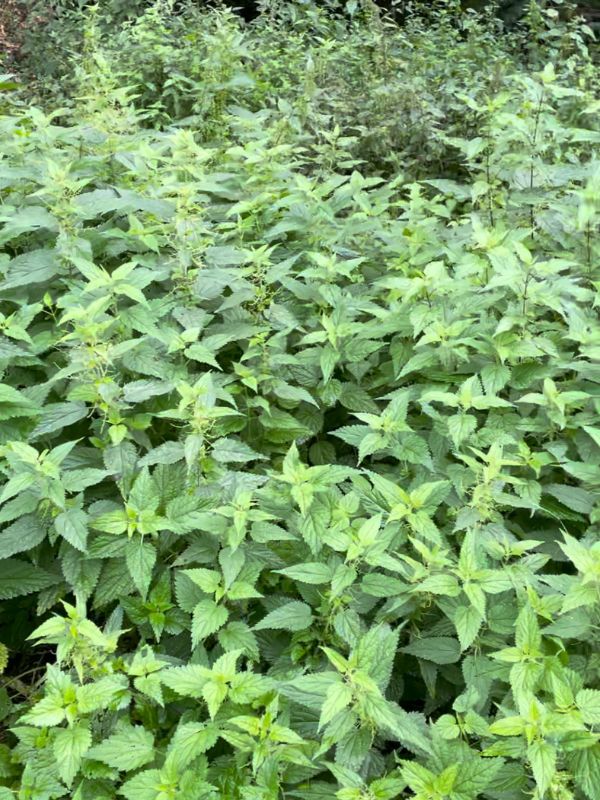
Step 2: Washing
It goes without saying, but I’ll say it anyway: you need to wash your harvest thoroughly! This step is crucial for removing any dirt, insects, or potential pollutants from your stinging nettle. Rinse the leaves under cool running water, and if you want to be extra thorough, soak them in a bowl of water with some baking soda and a spritz of either lemon essential oil or lemon juice for a few minutes before rinsing again. This little trick helps ensure your nettle is as clean as possible before using it in your infusion.
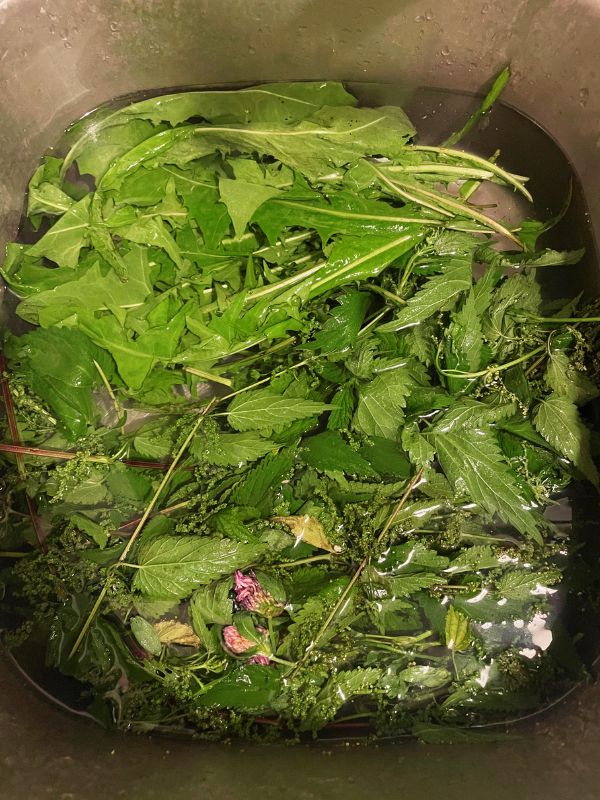
Step 3: Drying
After harvesting and rinsing the leaves thoroughly, you have two options: you can either use the fresh leaves right away to start your stinging nettle infusion or dry them first. To dry the leaves, hang them in a warm, airy place. If you have a dehydrator, that works too! But honestly, there’s something special about simply letting them hang in your witchy kitchen; it adds a rustic charm and cozy atmosphere that makes the whole process feel magical. And I’m all for magic!
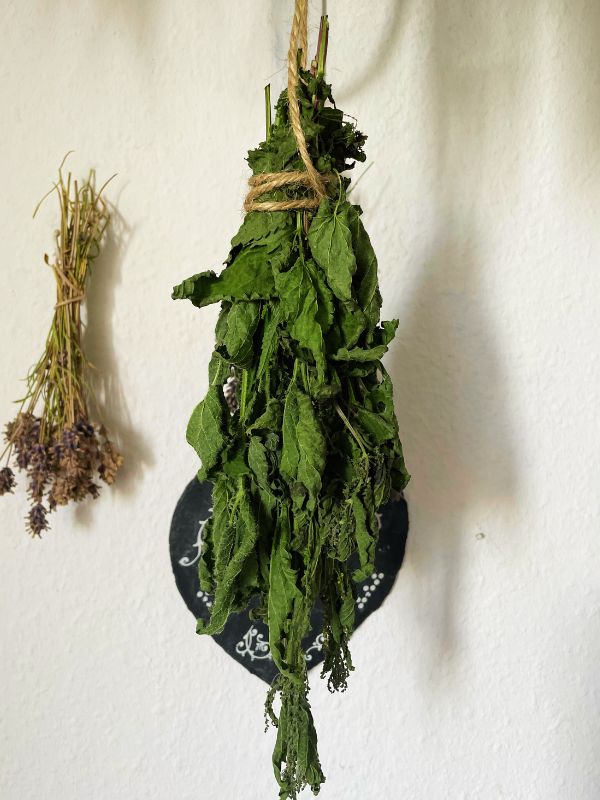
Step 4: Brewing
To make your infusion, start by adding 2 to 3 handfuls of dried nettle leaves to a large mason jar. Pour in boiling water until the jar is full, then close the lid and let it steep for at least 8 hours. If you can, let it steep for a full 24 hours for even richer flavor and nutrients. Once it’s done steeping, strain out the leaves, et voilà! Store your infusion in the fridge, and you’ll have a refreshing, nutrient-packed drink ready to enjoy.
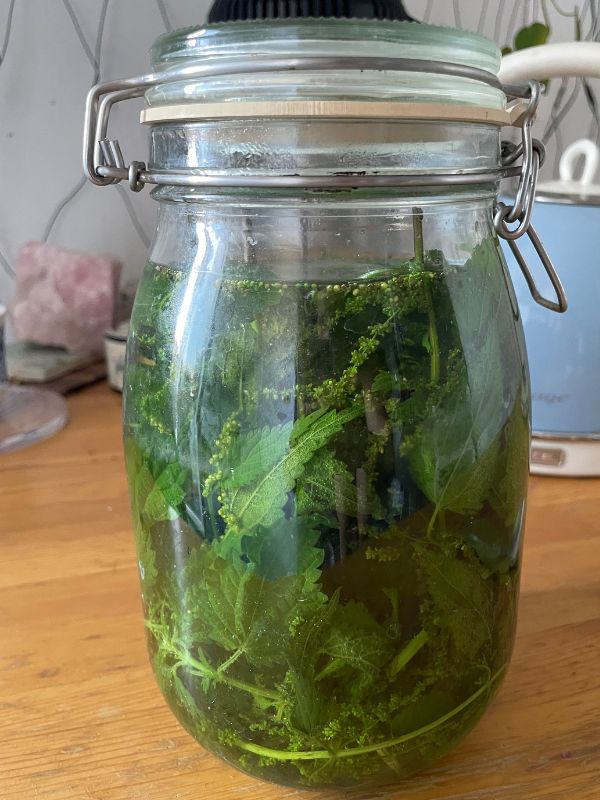
Step 5: Enjoying
Now, the best part: Pour the infusion into a cup and enjoy it warm or chilled—whichever you prefer! If you can, aim to drink about 1 liter of stinging nettle infusion during your menstruation for an extra boost. But honestly, I recommend sipping on it daily, especially during the colder months when your body craves replenishment. If you find the flavor too strong, you can easily enhance it with a touch of raw honey or a squeeze of lemon, lime or orange for a delightful twist.
So, Are You stoked about it?
I hope I’ve inspired you to drink more stinging nettle tea and infusion! My enthusiasm is contagious, and I truly encourage you to carry some scissors with you so you can harvest this magical plant whenever you can.
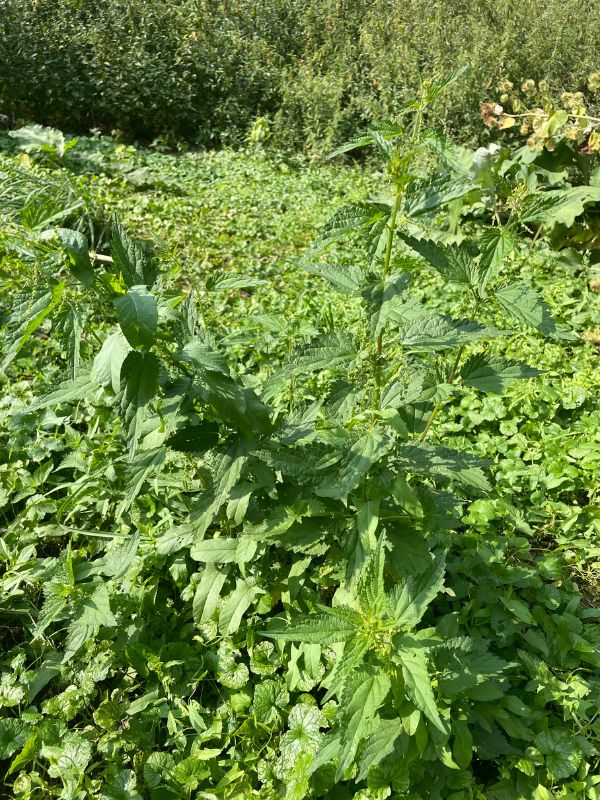
During winter, I store my dried stinging nettle in big containers, and it lasts throughout the cold season—no need to buy it! Stinging nettle is truly a powerful game-changer for women’s health. Its nutritional and medicinal properties make it a valuable addition to your wellness routine.
So, give stinging nettle a try, my dear, and see how this ancient herb can enhance your health. I’d love to hear about your experiences, so please share them with me in the comments!
Additional Tips and Warnings
- Safety Tips: Always wear gloves when handling fresh stinging nettle to avoid skin irritation.
- Allergies and Interactions: If you’re pregnant, nursing, or on medication, consult with a healthcare provider before using stinging nettle to ensure it’s safe for you.

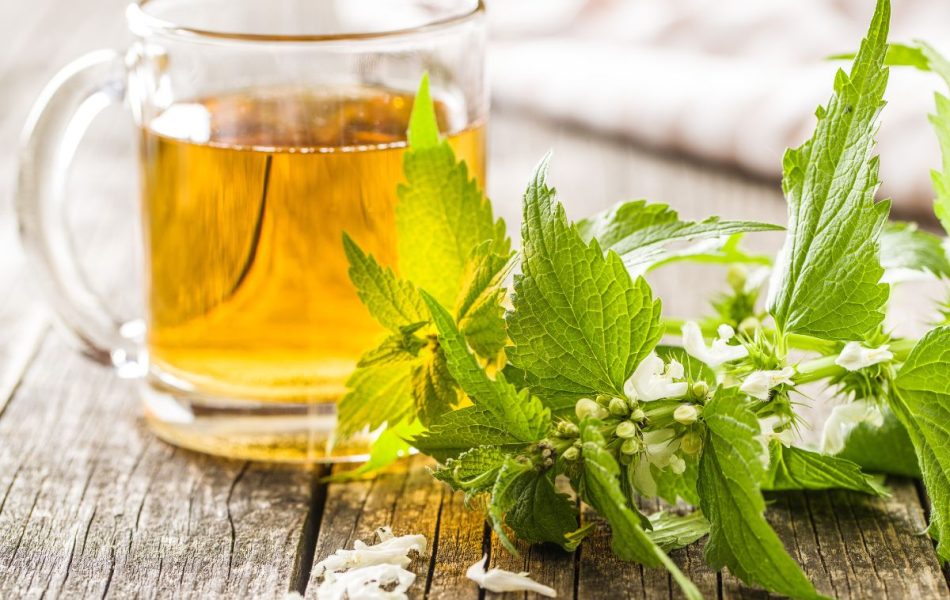



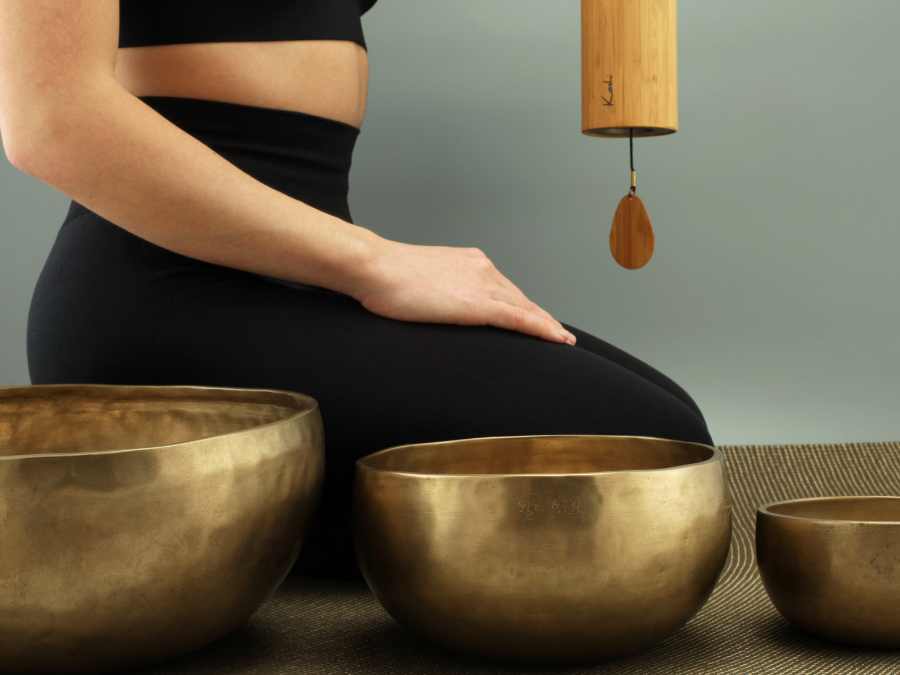
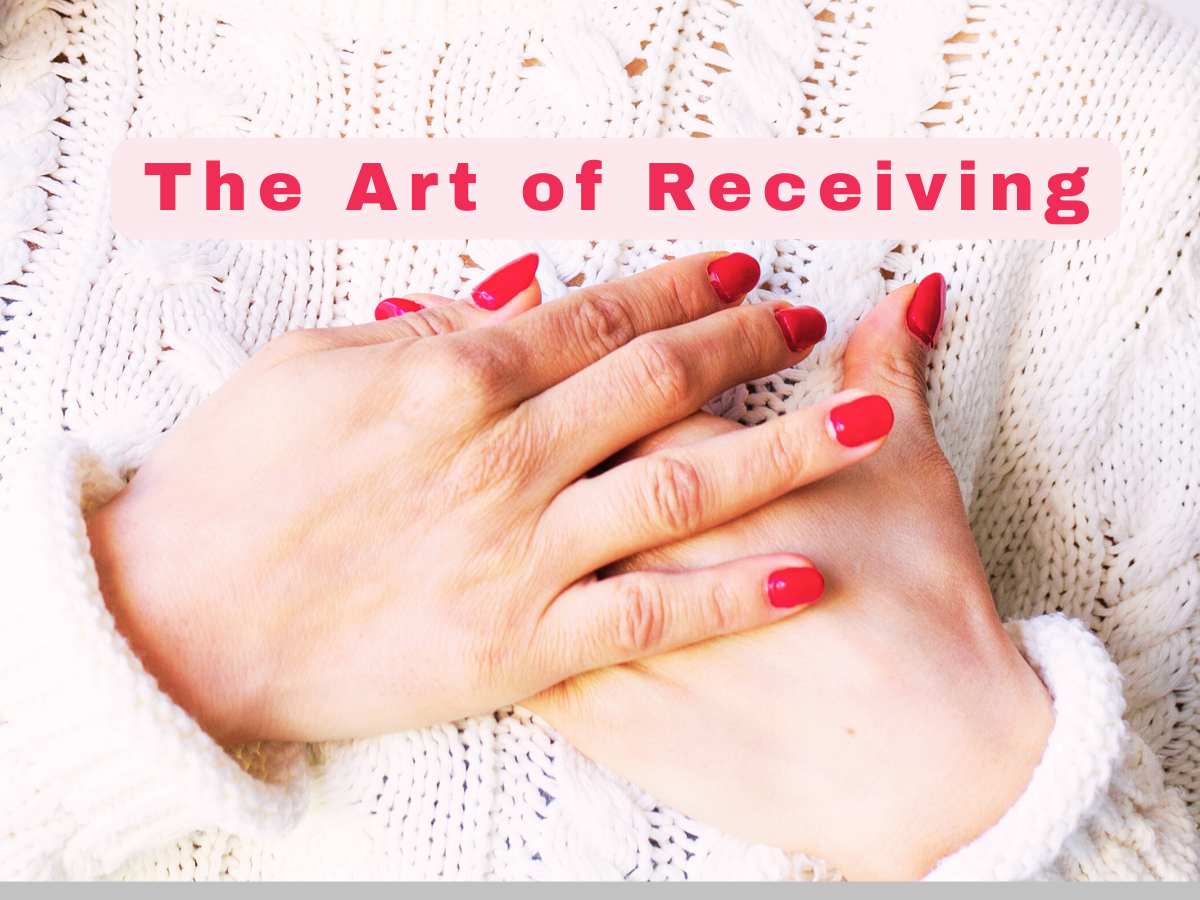




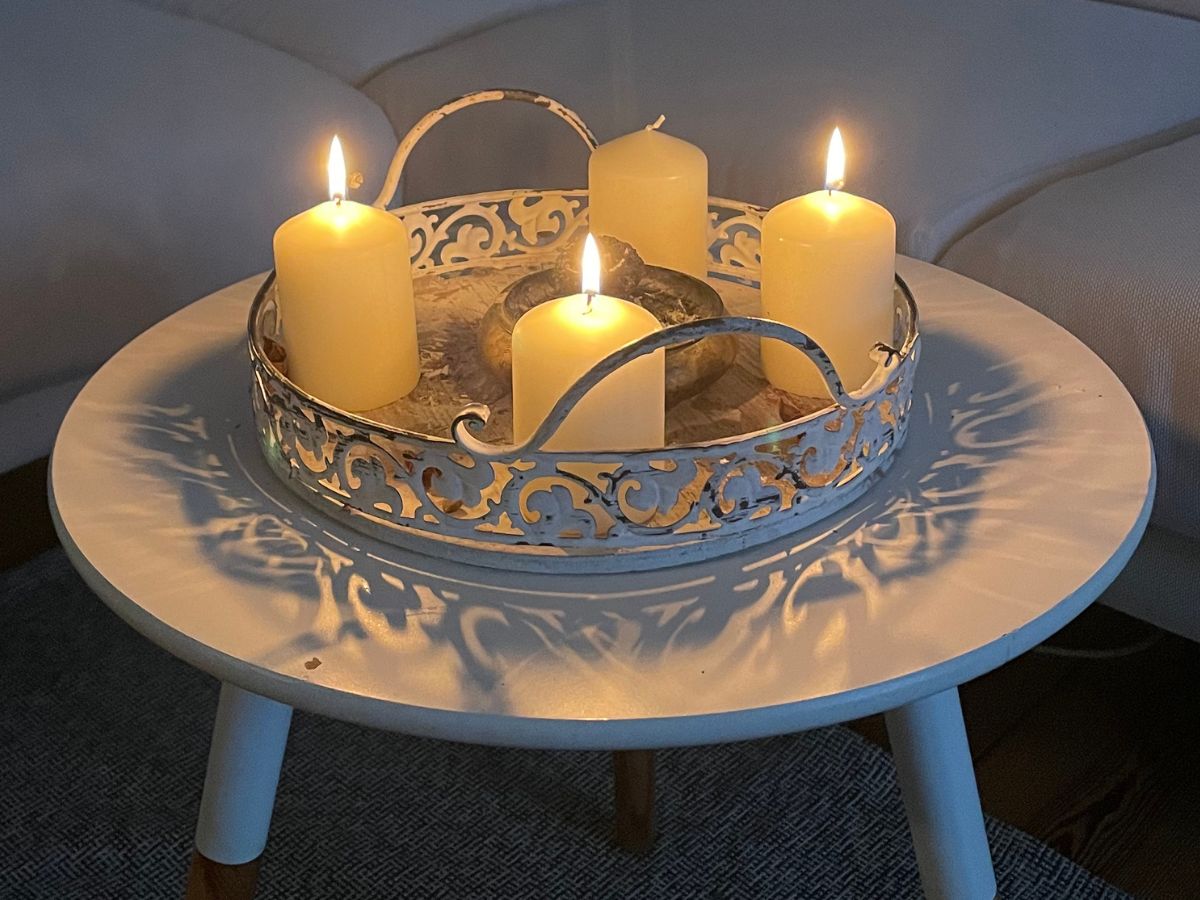




Leave a Comment